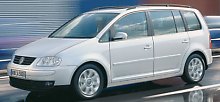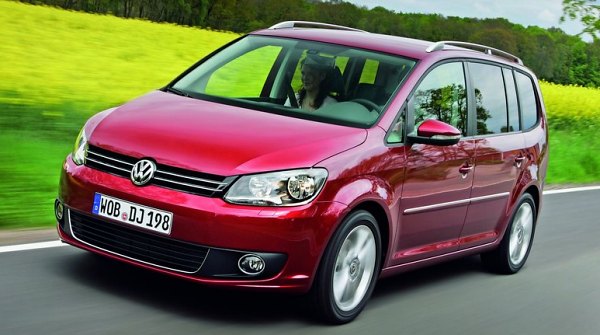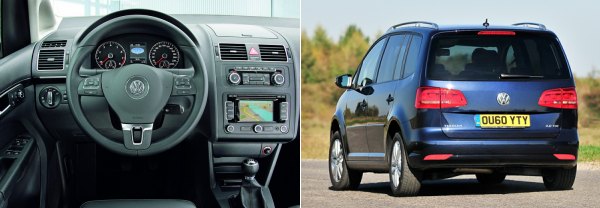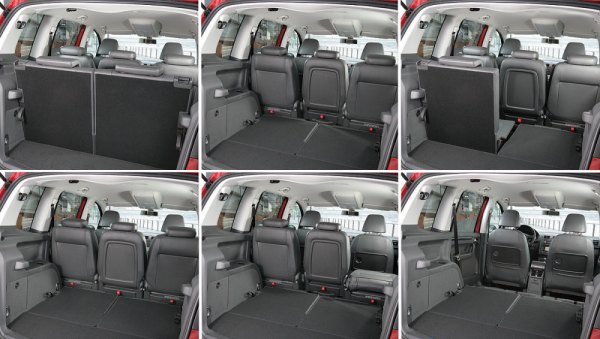|
|
Volkswagen Touran
|
 |
|
|
Debut: 2003
Maker: Volkswagen
Predecessor:
no
|
|
|
|
Published
on 13
Dec 2003
|
All rights reserved.
|
|
 In
the era of Ferdinand Piech, Volkswagen poured too much resources into
ambitious
plans like Phaeton, W12 supercar, Bentley, Lamborghini and Bugatti.
This
sounded exciting to car enthusiasts, but did nothing good to
Volkswagen’s
own business. The most apparent is its failure to get on the trend of
MAC
(Multi-Activity Cars, or mini-MPV). For 7 long years since the debut of
Renault Scenic, Volkswagen did not have any products to compete in this
big-selling segment. This was not changed until the arrival of new boss
Bernd Pischetsrieder and Volkswagen Touran. In
the era of Ferdinand Piech, Volkswagen poured too much resources into
ambitious
plans like Phaeton, W12 supercar, Bentley, Lamborghini and Bugatti.
This
sounded exciting to car enthusiasts, but did nothing good to
Volkswagen’s
own business. The most apparent is its failure to get on the trend of
MAC
(Multi-Activity Cars, or mini-MPV). For 7 long years since the debut of
Renault Scenic, Volkswagen did not have any products to compete in this
big-selling segment. This was not changed until the arrival of new boss
Bernd Pischetsrieder and Volkswagen Touran.
The
Touran is the first car in Volkswagen group to use the new A5 platform,
or more commonly known as "Golf V platform". The biggest advantage of
this
platform is the use of multi-link rear suspensions and a rigid
bodyshell.
Other new technologies include electric power steering, FSI direct
injection
gasoline engines, 16-valve diesel engine and 6-speed gearbox. Besides,
the Touran also offers an optional third row of seats to make it a
7-seater.
On paper, no other MAC can rival it.
In
real world, does it deliver what it promised?
The
Touran is actually a well engineered car. Its sophisticated suspensions
give it good handling and ride. Its body control remains excellent on
bumpy
surfaces. Its terminal understeer suits the driving style of MAC
drivers.
Its steering is precise and well weighted, despite of lacking feel. It
is rigid and tightly screwed together, although old customers will be
disappointed
that Volkswagen saves money by using many low-rent plastics in the
cabin.
Its diesel engines are strong and performance is class-leading.
But
in the end, the Touran fails to win hearts. The problem is its
designers
didn’t know what make people buy MAC. Look at its blend, boxy shape and
you know why. The Touran is by no means fun to look. Enter the cabin
and
the disappointment is even greater - the dashboard design is dull, the
plastics are gray, the ambience is dark. This is not a happy place for
your family and kids to spend a weekend travelling.
The
designers also failed to make the third row of seats right. Access to
there
is difficult. Head and legroom is unbearable for adults, even for short
journeys. The seat can be folded flat onto the luggage floor, but
unfortunately
you have to detach the headrests first. For comparison, Renault Scenic
is cleverer. Its 7-seat version has a longer wheelbase to provide the
necessary
extra room.
More
unfortunate to Touran is that Renault Scenic now offers a
higher-quality,
more expensive-feeling and far more desirable cabin. Volkswagen’s
products
used to shine in quality contest. Now no more in Touran. |
Verdict:    |
| Published
on 23
May
2014 |
All rights reserved.
|
|
Touran update 2010
|
|

|
It is easy to overlook
Volkswagen Touran in the seas of compact MPVs because it looks so
bland. However, the Touran actually outsells most rivals, including
Renault Scenic, Citroen C4 Picasso, Peugeot 5008 and Opel Zafira (note:
Ford did not reveal the sales figure of its C-Max). In the last 10
years it sold more than 1.5 million copies. Even near the end of its
lifecycle it still shifted some 135,000 units last year. Thanks must
goes to its all-round ability.
The Touran was introduced in 2003 as a late response to Renault Scenic.
Over the last 10 years it received a couple of facelift, first in 2006
and then a larger scale revamp in 2010, which is the car shown here.
Besides, there were frequent updates of engines and equipment to keep
it up to date. The 2010 facelift made it a little bit more stylish,
although its boxy profile was not altered. Inside, the dashboard kept
the same old-school design and construction (which came from Golf Mk5,
if you remember) but adopted better plastics and added some chrome
bezels to inject a new lease of quality feel. It still lacks the
inviting ambience of, say, Citroen C4 Picasso, or the modern look of
most other rivals. Furthermore, dark plastics and the absence of
panoramic glass roof rob it of a light and airy feel that is important
to an MPV. These problems will not be rectified before an all-new
generation arrived.

|
Despite of new seat trims, the seating arrangement is the same as
before. The Touran can be ordered with either 5 seats or 7 seats. The
latter employs the same body with a short wheelbase of 2678 mm. This
explains why the last row of seats suits only children. Average-size
adults would find its knee room too tight and foot well too shallow.
Moreover, unless you are Olympic gymnastic player, getting into the
rearmost seat is incredibly difficult, because the short wheelbase
has the length of rear doors limited. The same short wheelbase also
compromises the
second row legroom, so you won’t find it as spacious as, say, Citroen
C4 Picasso, Ford C-Max or Opel Zafira. After all, the Touran is derived
from the old PQ35 platform of Golf Mk5. It lacks the flexibility of
newer platforms thus rules out of the possibility of extended
wheelbase.
The seats of Touran are highly configurable, but they are not as
convenient to use as newer rivals. The third row is 50/50-split and can
be folded flush into the luggage floor, which is good. Not so good is
the second row. It consists of 3 individual seats (though the middle
one is a bit narrower, as the cabin is not wide enough to fit 3 proper
seats) that can fold or slide fore and aft independently. Nevertheless,
unlike most rivals they don’t fold flat into the floor or tumble
forward to release a flat cargo floor. Instead, you need to detach the
seats to maximize luggage space, which is rather inconvenient. If you
take only 2 guys in the second row, you can give them extra shoulder
room by abandoning the middle seat and attaching the outer seats at
mounting points located closer the center line. Again, it is not as
convenient as some rivals, such as C-Max, Zafira and Meriva, which are
capable of converting from 3 to 2 seats by simple folding and sliding
actions.

|
However, the Touran is better to drive. In fact, among all compact MPVs
its handling is one of the best. It grips well, resists roll remarkably
and steers accurately (if lacking feel). Despite of its age, the Golf V
platform with multi-link rear suspension still does the job admirably.
Stiffer springs mean ride comfort is not going to rival the French
cars, but it is far from uncomfortable. The balance between ride and
handling is similar to C-Max, although the latter has a sweeter
steering and better NVH suppression.
Volkswagen’s engines and transmissions are also competitive. No matter
you choose the 140 hp 1.4 TSI petrol, 105 hp 1.6 TDI, 140 hp 2.0 TDI or
177 hp 2.0 TDI turbo diesel, you will get good performance, flexibility
and
refinement. The Touran goes better than it looks.
|
Verdict:    |
|
|
|
|
|
|
|
|
|
|
Touran
1.6 FSI
|
2003
|
| Front-engined,
FWD |
| Steel monocoque |
| Mainly steel |
| 4391 / 1770 / 1634 mm |
| 2677 mm |
Inline-4
|
| 1598 cc |
DOHC 16 valves
|
| VIM |
| DI |
115 hp
|
114 lbft
|
6-speed manual
|
F: strut
R: multi-link
|
| - |
| 205/55R16 |
1423 kg
|
112 mph*
|
12.2*
|
| - |
|
Touran
2.0TDI
|
2003
|
| Front-engined,
FWD |
| Steel monocoque |
| Mainly steel |
| 4391 / 1770 / 1634 mm |
| 2677 mm |
Inline-4, diesel
|
| 1968 cc |
DOHC 16 valves
|
| Turbo |
Pump direct injection
|
136 hp
|
236 lbft
|
6-speed manual
|
F: strut
R: multi-link
|
| - |
| 205/55R16 |
1561 kg
|
122 mph (c)
|
9.7*
|
| 33.8* |
|
|
|
|
|
|
Performance
tested by: *Autocar
|
|
|
|
|
|
|
Touran 1.4TSI
|
2010
|
| Front-engined,
FWD |
| Steel monocoque |
| Mainly steel |
| 4397 / 1794 / 1674 mm |
| 2678 mm |
Inline-4
|
| 1390 cc |
DOHC 16 valves
|
| Turbo |
DI
|
140 hp
|
162 lbft
|
6-speed manual
|
F: strut
R: multi-link
|
| - |
| 205/55R16 |
-
|
125 mph (c)
|
8.9 (c)
|
| - |
|
Touran 2.0TDI
|
2010
|
| Front-engined,
FWD |
| Steel monocoque |
| Mainly steel |
| 4397 / 1794 / 1674 mm |
| 2678 mm |
Inline-4, diesel
|
| 1968 cc |
DOHC 16 valves
|
| VTG turbo |
CDI
|
140 hp
|
236 lbft
|
6-speed manual
|
F: strut
R: multi-link
|
| - |
| 205/55R16 |
-
|
121 mph (c)
|
9.7 (c)
|
| - |
|
|
|
|
|
|
Performance tested by: -
|
|
|
|
|
|
|
|
|
Copyright©
1997-2014
by Mark Wan @ AutoZine
|
|